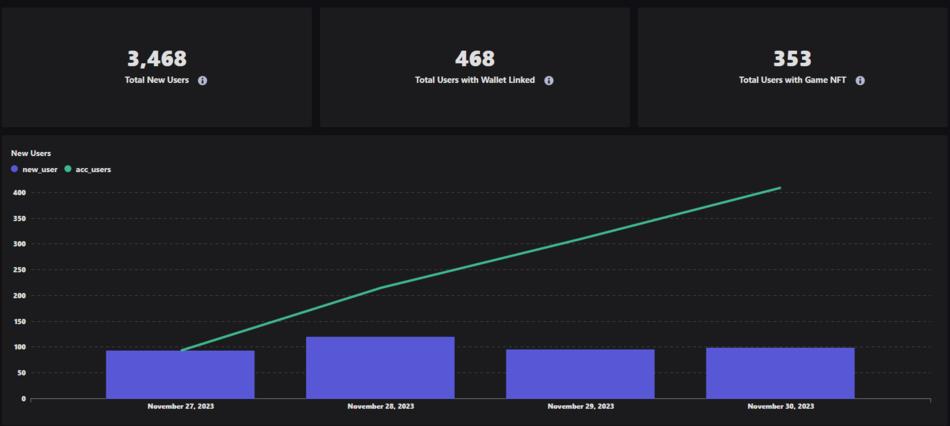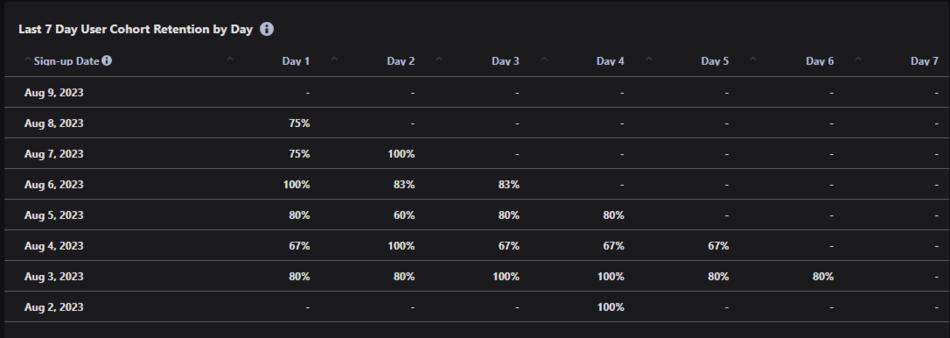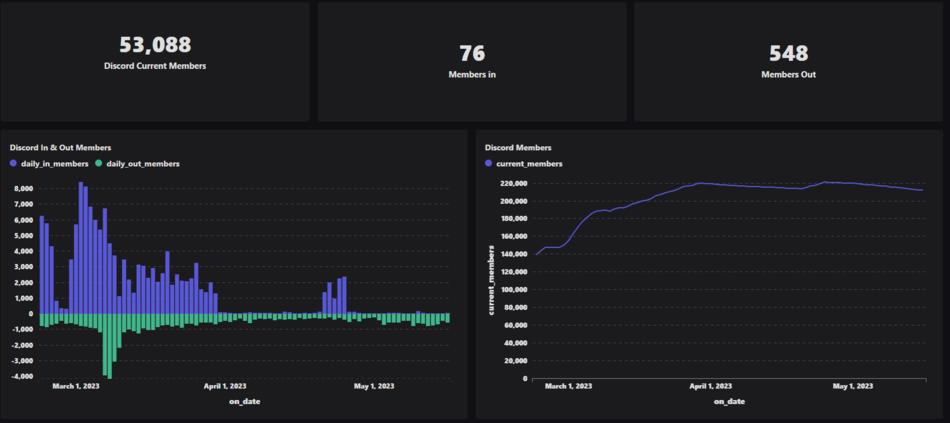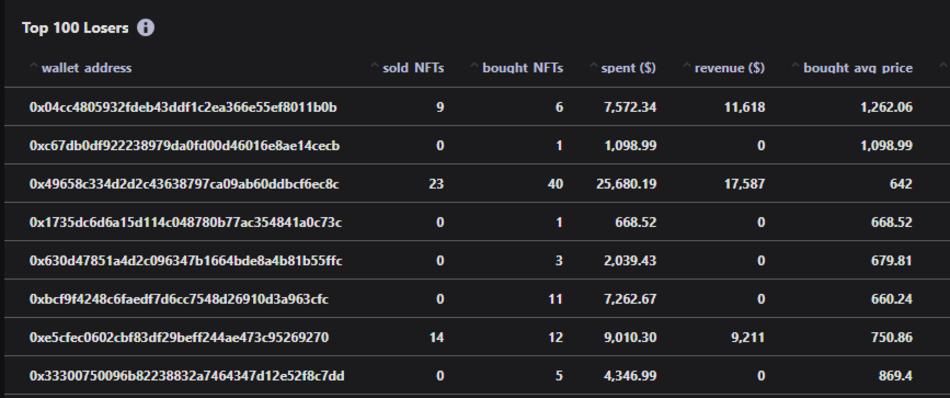Original author: lesley@footprint.network
In the fiercely competitive Web3 game industry, success does not only depend on the release of the game, but also requires a high degree of acumen in the game operation process to cope with the coming of the next bull market.
People are confident about the gaming industry in 2024. Marketing manager of A16Z GAMES and GAMES FUND ONEDoug McCracken said: A lot of people in the market have been talking about Disney re-entering the video game market recently, but I think a certain video game company will become the next Disney.
The booming Web3 game industry has put forward higher requirements for operation professionals. In order to improve user retention, increase user engagement, and extend the life cycle of game products, in-depth data analysis has become crucial.
This article provides an in-depth exploration of Web3 game data analysis methods, providing game developers with valuable insights into analysis methods, tool exploration, and more.
A guide to data analysis for Web3 game developers
As the market recovers, the Web3 gaming market has also shown good signs of development since December.
However, we must realize that Web3 gaming is still in its infancy, and the number of active participants lags far behind the Web2 gaming community. All industry practitioners are actively working to explore ways to ensure the sustainability and mass popularization of Web3 games.
In the early stages of a game, it is crucial to analyze market segmentation, competitor data, and on-chain participation data. But what really changes the fate of a game is customer acquisition in the mid-term. Developers should pay close attention to user-related data, revenue indicators, and maintain the latest understanding of industry developments.
Data analysis rules that Web3 game developers should keep in mind
Web3 game developers should note that accurate data analysis is important for making informed decisions.
In Web3, a common method for developing games is to start with creative narratives, attract high-quality early users, and then find ways to analyze user portraits and optimize the game experience to expand the user base. Developers need to collect comprehensive data for in-depth analysis, so as to break personal subjective biases and reliance on experience and promote game development more objectively.
The data dimensions that developers should pay attention to include: monitoring user retention and churn to promote continued growth of the game; identifying the behavior patterns of players participating in the game to design more attractive game mechanics; evaluating different profit models to optimize the game. Earnings etc.
User data: the key to success in the gaming market
As one of the top three dApps, we are successful because we deeply understand customer needs, accurately locate acquisition channels, and ensure that users have a good experience in our applications so that they are willing to continue using it.
——Wali Khan, co-founder of Gamifly
In the field of Web3 games, user-related data plays a very important role, including user acquisition-related data and user portrait analysis.
In the Web3 economic ecosystem, users are not only players, but also creators and investors, and are the key to the economic value of the game. The active participation of players is crucial to the sustainable development of the game ecosystem.

User related data
“Understanding the sources of new users is crucial to optimizing marketing strategies and effectively allocating resources,” said Krish Jagirdar, co-founder of Internet Game.
Game developers can explore high-value user behavior patterns through user data and typical user portraits.
At the same time, re-engagement analysis of inactive users can also help reduce user churn and improve the overall health of the game ecosystem.
Active data is the cornerstone of sustainable development of games
The success of Web3 games often relies on an active community. Monitoring community metrics helps measure the health of player interactions beyond the game itself.
——Krish Jagirdar, co-founder of Internet Game
In order for the game to continue to develop, in addition to attracting new users, it is also important to pay attention to user activity data. This is because active user data can reflect users recognition of the games playability or economic model, showing that they are willing to invest time, energy and even money for the fun or rewards of the game.

User seven-day retention rate
In the field of Web3 games, user retention rate is also an indicator that cannot be ignored. In this attention-scarce field, the cost of attracting new users is high, so it is more economical for projects to strive to retain existing users. Retention rate is an important indicator in the current market, similar to Web2. High retention rate means that users not only enjoy the game, but also agree with its economic model, which reflects their acceptance of the game product, Hoshino, community ambassador of Outer.gg Sasaki said.

Community engagement data for Web3 games
Community participation is also important in Web3. An active community represents a diverse group of individuals who actively participate in the gaming ecosystem. Participants in gaming communities typically include players, analysts, community ambassadors, etc. The official game community is the main channel for players to obtain official announcements, and is also the main battlefield for community members to interact. Therefore, analyzing community data, such as trends in membership numbers and community participation, is crucial for game developers.
Currently, the inability to integrate Web2 and Web3 data for analysis is a major challenge, which complicates analysis around the entire user funnel. Footprint Growth Analytics is able toConnecting Web2 and Web3 data, providing a holistic perspective for comprehensive analysis of data.

Integration of Web2 and Web3 data
Revenue data is the compass for strategic decisions
At this stage, Web3 is still an area that needs funding and financial support. The amount of money the user community is willing to invest in the game directly reflects the market share of the game project to a certain extent.
——Hoshino Sasaki, Community Ambassador at Outer.gg
Revenue data is extremely important in Web3 games. On the one hand, team income is the cornerstone of project development; on the other hand, user income is crucial to retaining early users, especially in the rapidly developing Web3 game industry.
In the early days of Web3 games, the first thing most developers had to do was to build the games economic model so that they could attract more users through the play-to-earn model.
While the foundation of revenue lies in the design of the economic model, ongoing revenue monitoring is equally important once the game is running stably. This allows developers to adjust game design in a timely manner to attract more users. Revenue levels and growth directly affect how external investors and the market view the value of the game.

Project NFT income
Monitoring the value of blockchain games includes tracking the prices and circulation of NFTs and game tokens.
“In blockchain gaming, the success of NFTs is critical. Monitoring NFT ownership, transactions, and rarity metrics can provide users with important data on the popularity and value of in-game assets,” said Krish Jagirdar.

Top 100 losers
In addition, paying close attention to the profitable and losing players in the market and studying whether the games reward system meets the users expectations and motivations provide a profound perspective for analyzing the design of the games economic model. They are also an important tool for identifying the reasons for user churn. Some reasons, such as a mismatch between effort and reward, difficulty in making money for new users, inflation eroding profits, or speculation squeezing long-term investment, may cause the game to lose users.
Data analysis tools for Web3 game developers
Many games currently rely on simple Web2 tools to monitor game performance, including Google Analytics and SimilarWeb. Some larger companies, such as Gamifly, have begun developing in-house analytics solutions.
“I think the Web3 data analysis tools industry is still in its infancy, and widespread adoption by game developers has yet to materialize. I believe that good game data analysis companies like Footprint Analytics will become more and more popular over time. A lot,” Krish Jagirdar said.
While using Web2 software may provide some basic data, they fall far short of providing deep insight into the complex world of Web3 games. Additionally, for start-up Web3 games, developing in-house analytics tools is a challenge due to the complexity and cost of indexing Web3 data.
However, we need to realize that data analysis should not become a high-barrier thing. Effective use of data analysis tools to strategically capture key on-chain and off-chain data can provide important support for the decision-making and development of Web3 games.
This is a commonly used tool by some Web3 game developers.

Footprint Growth Analytics
Footprint Growth Analytics
Footprint Growth Analytics is the preferred analytics tool for Web3 game developers, providing comprehensive data on more than 30 blockchains and a user-friendly website that simplifies the data utilization process. Footprint provides comprehensive features such as asset performance, revenue analysis, wallet data, user exploration and onboarding, making it easy for game developers to gain valuable insights to optimize their projects. Footprint allows game developers to easily use data to promote informed decision-making and promote better survival of Web3 games in the ever-changing market.
Degame

Degame
DeGame is the worlds largest NFT game aggregator. Since its launch in 2021, it has listed more than 4,000 blockchain game projects and 1,000+ game tokens game chains. DeGame has established partnerships with more than 50 guilds and public chains, providing a one-stop service platform for NFT game enthusiasts and developers. In 2023, DeGame launched the Proof of Contribution platform DeGame Community, a one-stop shop for Web3 users around the world to discover and play the most exciting new projects and games. Early developers, project ambassadors, KOLs, and community organizers can demonstrate their contribution to the project and be recognized through status roles and rewards.
Galxe

Galxe
Galxe is a mission-critical platform designed to help games grow and solve customer acquisition challenges for Web3 games. The platform provides games with the opportunity to publish tasks such as registering for games, joining communities and providing incentives. As the leading platform for building Web3 communities, Galxe currently attracts more than 14 million unique users and drives growth through rewards-based loyalty programs for Optimism, Polygon, Arbitrum and more than 4,000 partners.
summary
Web3 games are still in the early stages of development. Although game data analysis still faces some challenges such as data acquisition and processing, the importance of data analysis cannot be ignored.
Data analysis is not only not a burden for developers, but a powerful tool to enhance the core competitiveness of the project. Developers should have a data-driven mindset and seek professional data analysis services to facilitate the continued growth of the project.
In addition, the entire Web3 data industry should strive to break down data barriers and better collaborate to create infrastructure. In this way, data can play a key role in promoting the prosperity and development of the Web3 gaming industry.
Footprint AnalyticsIs a blockchain data solutions provider. With the help of cutting-edge artificial intelligence technology, we provide the first code-free data analysis platform and unified data API in the Crypto field, allowing users to quickly retrieve NFT, Game and wallet address fund flow tracking data of more than 30 public chain ecosystems.
Product Highlights
For developersData API
for GameFi projectFootprint Growth Analytics (FGA)
Big data batch download functionBatch download
All provided by Footprintdata set
Check out our Twitter (Footprint_Data)Learn more about product updates